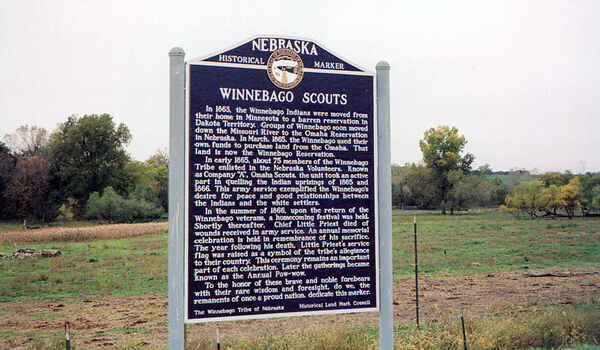Difference between revisions of "Nebraska Historical Marker: Winnebago Scouts"
(Created page with "[[Image:________ |thumb|center|upright=3.0|alt=________]] ==Location== Rural U.S. 77, Winnebago, Thurston County, Nebraska View this marker's location '''[https://maps.googl...") |
|||
| (3 intermediate revisions by 3 users not shown) | |||
| Line 1: | Line 1: | ||
| − | [[Image: | + | [[Image:NHM_44_1_11.jpg|thumb|center|upright=3.0|alt=NHM_44_1_11.jpg]] |
==Location== | ==Location== | ||
| − | Rural U.S. | + | Rural U.S. 75, .5 mile north of Winnebago, Thurston County, Nebraska |
| − | View this marker's location '''[https://maps.google.com/maps?q=42.245688,+-96.47323&hl=en&sll=41.982136,-100.537498&sspn=0.006819,0.013937&t=h&z=16 42. | + | View this marker's location '''[https://maps.google.com/maps?q=42.245688,+-96.47323&hl=en&sll=41.982136,-100.537498&sspn=0.006819,0.013937&t=h&z=16 42.245587, -96.472928] |
| − | + | {{Marker:Map}} | |
==Marker Text== | ==Marker Text== | ||
''In 1863, the Winnebago Indians were moved from their home in Minnesota to a barren reservation in Dakota Territory. Groups of Winnebago soon moved down the Missouri River to the Omaha Reservation in Nebraska. In March, 1865, the Winnebago used their own funds to purchase land from the Omaha. That land is now the Winnebago Reservation. | ''In 1863, the Winnebago Indians were moved from their home in Minnesota to a barren reservation in Dakota Territory. Groups of Winnebago soon moved down the Missouri River to the Omaha Reservation in Nebraska. In March, 1865, the Winnebago used their own funds to purchase land from the Omaha. That land is now the Winnebago Reservation. | ||
| + | |||
''In early 1865, about 75 members of the Winnebago Tribe enlisted in the Nebraska Volunteers. Known as Company "A", Omaha Scouts, the unit took an active part in quelling the Indian uprising of 1865 and 1866. This army service exemplified the Winnebago's desire for peace and good relationships between the Indians and the white settlers. | ''In early 1865, about 75 members of the Winnebago Tribe enlisted in the Nebraska Volunteers. Known as Company "A", Omaha Scouts, the unit took an active part in quelling the Indian uprising of 1865 and 1866. This army service exemplified the Winnebago's desire for peace and good relationships between the Indians and the white settlers. | ||
| + | |||
''In the summer of 1866, upon the return of the Winnebago veterans, a homecoming festival was held. Shortly thereafter, Chief Little Priest died of wounds received in army service. An annual memorial celebration is held in remembrance of his sacrifice. The year following his death, Little Priest's service flag was raised as a symbol of the tribe's allegiance to their country. This ceremony remains an important part of each celebration. Later the gatherings became known as the Annual Pow-wow. | ''In the summer of 1866, upon the return of the Winnebago veterans, a homecoming festival was held. Shortly thereafter, Chief Little Priest died of wounds received in army service. An annual memorial celebration is held in remembrance of his sacrifice. The year following his death, Little Priest's service flag was raised as a symbol of the tribe's allegiance to their country. This ceremony remains an important part of each celebration. Later the gatherings became known as the Annual Pow-wow. | ||
| + | |||
''To the honor of these brave and noble forebears with their rare wisdom and foresight, do we, the remnants of once a proud nation, dedicate this marker. | ''To the honor of these brave and noble forebears with their rare wisdom and foresight, do we, the remnants of once a proud nation, dedicate this marker. | ||
==Further Information== | ==Further Information== | ||
| + | [[Image:Winnebago_Chief_Little_Priest%27s_whip.jpg|thumb|center|upright=3.0|alt=Winnebago_Chief_Little_Priest%27s_whip.jpg]] | ||
==Bibliography== | ==Bibliography== | ||
| − | + | {{Marker:Program}} | |
| − | + | ||
Latest revision as of 13:25, 22 January 2018
Location
Rural U.S. 75, .5 mile north of Winnebago, Thurston County, Nebraska
View this marker's location 42.245587, -96.472928
View a map of all Nebraska historical markers, Browse Historical Marker Map
Marker Text
In 1863, the Winnebago Indians were moved from their home in Minnesota to a barren reservation in Dakota Territory. Groups of Winnebago soon moved down the Missouri River to the Omaha Reservation in Nebraska. In March, 1865, the Winnebago used their own funds to purchase land from the Omaha. That land is now the Winnebago Reservation.
In early 1865, about 75 members of the Winnebago Tribe enlisted in the Nebraska Volunteers. Known as Company "A", Omaha Scouts, the unit took an active part in quelling the Indian uprising of 1865 and 1866. This army service exemplified the Winnebago's desire for peace and good relationships between the Indians and the white settlers.
In the summer of 1866, upon the return of the Winnebago veterans, a homecoming festival was held. Shortly thereafter, Chief Little Priest died of wounds received in army service. An annual memorial celebration is held in remembrance of his sacrifice. The year following his death, Little Priest's service flag was raised as a symbol of the tribe's allegiance to their country. This ceremony remains an important part of each celebration. Later the gatherings became known as the Annual Pow-wow.
To the honor of these brave and noble forebears with their rare wisdom and foresight, do we, the remnants of once a proud nation, dedicate this marker.
Further Information
Bibliography
Marker program
See Nebraska Historical Marker Program for more information.

